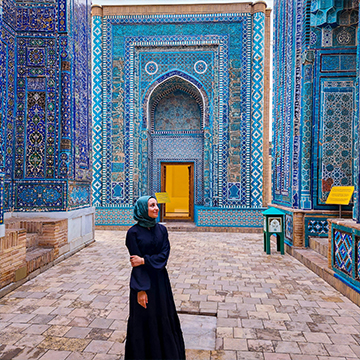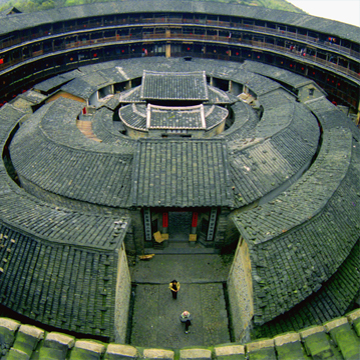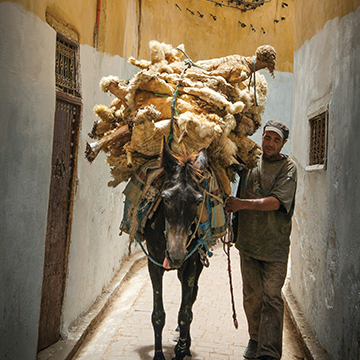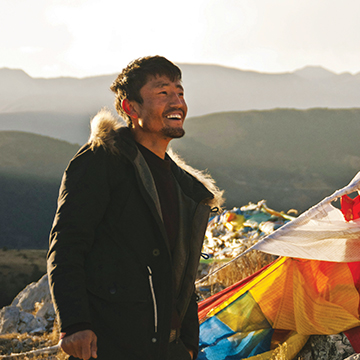Tibetan Buddhists
PRAYING FOR THE BUDDHIST WORLD EP 3
Circling Mountains, Waters, and Rebirth

1-10
That lifetime, I circled mountains, crossed waters,
and wandered through reincarnation-
not to cultivate a better next life,
but only to prepare for the moment I would meet you.
and wandered through reincarnation-
not to cultivate a better next life,
but only to prepare for the moment I would meet you.
— Tsangyang Gyatso (The Sixth Dalai Lama)
TIBETAN BUDDHISM
A Guided Journey Through Words
Padmasambhava
The Patriarch of Tibetan Vajrayana Buddhism
While the two wives of Songtsen Gampo introduced Buddhism to the Tibetan Plateau through royal marriage, it was Padmasambhava, a tantric master from India, who firmly established Vajrayana Buddhism in Tibet. With his supernatural power to subdue demons and outmatch local shamans, he helped the esoteric tradition flourish across the region. He founded the Nyingma school and the Samye Monastery, and his legends are still told throughout Tibet today.

Princess Wencheng and Princess Bhrikuti
Royal Brides on a Sacred Mission
Princess Bhrikuti from Nepal and Princess Wencheng from Chang’an were sent in marriage to the Tibetan King Songtsen Gampo. They brought with them Buddhist scriptures and sacred statues of the Buddha at ages 8 and 12. Together, they influenced the king to promote Buddhism across the land. In their honor, he built the Jokhang and Ramoche Temples. Tibetans revere the two princesses as emanations of White Tara and Green Tara—compassionate manifestations born from the tears of Avalokiteshvara.

Langdarma
The “Voldemort” of Tibetan Buddhism
In the 9th century, King Langdarma, a devout follower of the indigenous Bön religion, launched a violent suppression of Buddhism. His campaign silenced Tibetan Buddhism for nearly a century and nearly wiped it out entirely. Eventually, however, the faith returned from the Amdo and Kham regions to take root in Tibet once more.
Tsongkhapa
Reformer of Tibetan Buddhism
Tsongkhapa holds a place in Tibetan hearts much like Martin Luther does among Protestant Christians. In the 15th century (late Yuan and early Ming), as monastic discipline had waned and many monks pursued esoteric rituals over genuine Buddhist practice, Tsongkhapa called for a return to doctrinal purity. Emphasizing strict monastic discipline and deep study of the Dharma, he attracted many young followers and founded the Gelug school—the “Yellow Hat” tradition.
What does "tantric/esoteric practice" mean?
- It refers to advanced spiritual practices that are not easily understood or accessible to the general public.
- These practices integrate body (through mudras or ritual hand gestures), speech (through mantras), and mind (through meditation) in order to rapidly transform the practitioner's inner life and lead toward enlightenment.
Gospel Pioneers to Tibet

The Moravian Missionaries
The Moravian Church launched the earliest and largest Protestant missionary movement, with its missionaries even venturing into the snow-covered highlands at altitudes over 4,000 meters. Heinrich August Jaeschke, a linguistic genius, compiled the Tibetan-English Dictionary and Tibetan-German Dictionary, works that remain important academic references today. He and his colleagues Eduard Pagell and August Wilhelm Heyde collaborated to translate the Bible into Tibetan, laying a vital linguistic foundation for future mission work.
Despite battling illness, Pagell crossed treacherous mountains to vaccinate over 600 Tibetans against smallpox, but was later expelled by local officials. Recognizing the hardships faced by converts rejected by their communities, the missionaries set up farms and brought in hand-operated weaving machines, helping them earn a living and improve the region’s economy.

China Inland Mission Missionaries (now Overseas Missionary Fellowship)
In 1918, Frank D. Learner founded the "Tibetan Gospel Inn" in Xining, a gateway city to Tibetan regions. At the time, many Tibetan travelers were often swindled, but this inn offered free lodging and warm fires, becoming a safe haven where they could rest in peace. Tibetan pilgrims and even lamas would ask Learner to help with tooth extractions.
In the 1940s, British missionary Dr. Rupert Clarke opened a medical station in Hualong, Qinghai—a city with many lamas and Muslim imams. These spiritual leaders would line up outside the blue-eyed doctor’s clinic, patiently waiting to be treated. But Clarke ministered to more than just the body; he often carried gospel tracts in both Chinese and Arabic as he walked through streets and alleys, sharing about the greatest physician—Jesus Christ.
The Four Main Schools of Tibetan Buddhism
Red School Nyingma
The oldest school of Tibetan Buddhism, whose monks wear red hats. It primarily practices the "ancient mantras" (terma teachings) passed down by Padmasambhava. In times of natural disasters or calamities, local governments often invite Nyingma monks to perform rituals, offer prayers, and consult oracles. Some monks make a living by chanting scriptures and mantras, though they may not emphasize formal Buddhist study.
White School Kagyu
Following Hindu tradition, its monks wear white robes. This school focuses on the Mahamudra (Great Seal) teachings, emphasizing physical practices such as breath control, energy channels within the body, and meditative awareness. Its teachings are transmitted orally from teacher to disciple.
Flower School Sakya
Nicknamed the "Flower School" for the distinctive red, white, and black stripes painted on monastery walls—representing Manjushri, Avalokiteshvara, and Vajrapani. Sakya emphasizes scriptural translation and debate. It once held significant political power; the Yuan dynasty’s Imperial Preceptor, Phagpa, was one of its five founding patriarchs. It is the only Tibetan Buddhist school with a hereditary leadership system.
Yellow School Gelug
Known for monks wearing yellow hats, this is the school founded by Tsongkhapa. Though the most recent of the four, it grew to surpass the others in influence. It emphasizes a balanced and gradual approach to learning: first mastering Buddhist doctrine, then advancing to esoteric practices. The Gelug school has a well-structured hierarchy and educational system.

“It’s best never to meet, then we’d never fall in love; it’s best never to know each other, then we’d never long for one another…” This poem is so beautiful, isn’t it? >///<

Did you know? The author of this love poem was actually a lama in Tibetan Buddhism!

What!? A Buddhist lama writing love poetry? That’s unexpected!

How could one man be labeled both a “Living Buddha” and a “lovestruck soul”?
Tsangyang Gyatso, the Sixth Dalai Lama, was perhaps the most free-spirited and unconventional figure in the thousand-year relay of Tibetan reincarnated lamas.
Under the political acumen of the Fifth Dalai Lama, Tibet was unified after a period of fragmentation, and the Gelug school (the Yellow Hat sect) rose to dominance. The Dalai Lama became the supreme leader, combining both political and spiritual authority. But as this great leader neared the end of his life, and sensing the looming unrest both inside and outside Tibet, he and his closest confidants hatched an astonishing secret: they concealed his death—for fifteen years.
As time passed, eventually spies from rival factions and the Qing emperor began to sense something was amiss. Drepung Monastery was forced to admit the truth and identified a 15-year-old boy as the reincarnation of the Fifth Dalai Lama. From that moment on, his name entered the annals of history—but not for his spiritual devotion, rather for his rebellious heart and romantic soul.
Tsangyang Gyatso was found at age 14, and before his ordination at 15, his heart already belonged to a childhood sweetheart. All he longed for was the freedom to be a wandering shepherd, but the world demanded that he don monastic robes and bear Tibet’s most sacred responsibility.
Tsangyang refused to take full monastic vows. Only under the cover of night could he cast off his identity and roam Lhasa like a wayward youth, drinking, singing, and savoring life. He penned countless love poems, revealing not only passion but inner turmoil:
“How can there be a way to please both?
To be true to the Buddha and not betray my beloved?”
Tsangyang Gyatso was like a bold, unrestrained stroke of dark ink spilled across the carefully painted scroll of reincarnated lamas.
In the following pages, we’ll take a closer look at this ancient tradition—an unbroken chain of reincarnation passed from one generation to the next. We’ll explore the mysterious world of Tibetan Buddhism’s reincarnated lamas, and the unexpected influence they still hold today.
The Reincarnation Journey of a Tulku (Living Buddha)
What challenges must a senior monk face in his “return to the human world”?
- Why must a tulku “replicate” himself?
- Searching for the reincarnated soul boy—his next-life self!
- Who decides? The certification process of a Tulku
- Golden urn ritual: guarding against aristocratic interference
- Child leaders: trained from an early age!
Let’s dive in and explore together!



What Is a Reincarnated Lama (Tulku)?
And how is that different from a Rinpoche?
And how is that different from a Rinpoche?
In Tibetan Buddhism, Rinpoche is an honorific title for revered lamas, but not all Rinpoches are reincarnated lamas. A “Living Buddha” refers specifically to a high-ranking lama believed to be a reincarnation, known in Tibetan as tulku, meaning “emanation” or “reincarnated one.” Tibetan Buddhists believe that some enlightened lamas are reborn as children—known as reincarnated soul boy—to continue an unfinished spiritual mission. They are regarded as those who “return by vow.”
So how many reincarnated lamas are there? Estimates vary widely. After China’s 2007 enactment of the Measures on the Management of the Reincarnation of Living Buddhas in Tibetan Buddhism, only about 300 to 1,700 tulkus were officially recognized. But Zhang Weiming, founder of the Sichuan Institute for Tibetan Buddhist Culture , has said that including self-proclaimed tulkus and those recognized solely within their own monasteries, the number may exceed ten thousand.

Why Do High Lamas “Replicate” Themselves?
A system of succession that doesn’t rely on bloodlines
In the 13th century, a master of the Kagyu school (White School) instructed his disciples before his death to seek out his reincarnation to carry on his legacy. He left them three clues to find the reincarnated soul boy: a village name beginning with the Tibetan syllable “ba,” the names of the child’s parents, and an animal zodiac sign indicating a creature that walks on land.
However, it was Tsongkhapa, founder of the Gelug school (Yellow Sect), who institutionalized the tulku system and made it widespread. His two chief disciples established the lineages of the Dalai Lama and the Panchen Lama.
The four major tulku lineages of the Gelug school became key players in Tibetan religious and political life:
- The Dalai Lama governed Central Tibet (Ü region)
- The Panchen Lama governed Western Tibet (Tsang region)
- The Jebtsundamba Khutuktu influenced Outer Mongolia (present-day Mongolia)
- The Changkya Khutuktu influenced Inner Mongolia
| From a religious perspective | From a secular perspective |
Reincarnated lamas ensure the continuity of spiritual teachings, benefit sentient beings, and protect the Dharma. They also help stabilize monastic institutions. |
It’s a mechanism for transferring property, religious authority, and political power. |

Where Do They Find the Reincarnated Self?
The search party for the reincarnated soul boy sets off on a mystery quest!

Following the master's final wishes to find possible candidates—how do they know which child is truly their teacher reborn?

What!? A Buddhist lama writing love poetry? That’s unexpected!

- The child recalls details of a past life
- Correctly identifies possessions or former attendants
- Divinations are performed; Dharma protectors reveal visions in sacred lakes
- Multiple candidates may draw lots using tsampa (roasted barley flour)

The Official Selection Process: Golden Urn Lottery
Why did emperors in the Qing dynasty get involved in the selection of tulkus?
As mentioned earlier, reincarnation isn’t just a spiritual belief—it’s also a form of leadership succession. The reincarnation of a high-ranking lama signals a transfer of power, making it a magnet for political intervention.
The Qing emperors were devout followers of the Gelug school. But Emperor Qianlong discovered that Mongolian nobles were colluding with monastic protectors to pre-select noble children as reincarnated lamas, thereby expanding their family power.
To curb this, Qianlong introduced the Golden Urn lottery system, requiring that all major reincarnated lamas (such as the four key tulkus) be confirmed through a lot-drawing process to prevent manipulation by the nobility.
How Does the Golden Urn Lottery Work?
Is Reincarnation Still a Controversial Issue? Absolutely—and today, it’s more complex than ever. Since the 14th Dalai Lama fled to India and began distancing himself from China, he has worked to end the 400-year tradition of uniting religious and political power in the role of the Dalai Lama. He has repeatedly stated that he may choose not to reincarnate at all—or that if he does, his next incarnation could be outside of China.
This centuries-old cycle of reincarnation has never been just a matter of faith—it also reflects deeper struggles over power, identity, and cultural continuity.
When a reincarnated child is found, what’s truly being carried forward isn’t merely the life of a revered lama, but an entire social system—and the collective hopes and emotional investment bound up with it.
So now, let’s set aside a purely religious lens and take a closer look at the tulku system through a sociological perspective.

A Delicate Balance of Power

The long-standing tradition of the Dalai Lama and Panchen Lama serving as each other’s teacher and spiritual recognizer is an internal mechanism in Tibetan Buddhism for maintaining legitimacy and balance within the religious hierarchy. In contrast, the Golden Urn system represents an external check imposed by political authority. Throughout history, reincarnated lamas and their monasteries have had to navigate this intricate balancing act—carefully managing pressures from all sides.
The Power of Social Theater

The search for the soul boy and the rituals that follow unfold as a compelling form of social theater—public ceremonies that lay the foundation for a new leader’s authority and legitimacy. Each enthronement becomes a shared cultural moment, reinforcing both the community’s memory and the sacred stature of the role.
Influence That Spans Generations

When a revered lama passes away, the search for a soul boy—believed to carry the memory and wisdom of his previous life—becomes crucial to preserving spiritual authority, influence, and the prestige of the monastery. This tradition allows religious orders to transcend the rupture of death and succession, securing their standing over time. By sidestepping hereditary bloodlines, the reincarnation system creates a form of spiritual inheritance—one in which a leader’s charisma and legitimacy are built up and passed down across generations, strengthening the religious hierarchy.
Forming a Leader from Childhood

Once a child is recognized as a reincarnated lama, their path in life is completely transformed. They leave their birth family and enter the monastery, where they undergo intense training in religion, philosophy, and leadership. It’s a profound process of identity reformation. Through years of cultural immersion and psychological shaping, the child gradually internalizes society’s expectations of a Living Buddha—until they themselves become the embodiment of spiritual and communal leadership.

Tibetan Buddhists long for wisdom and hold their Living Buddhas in deep reverence. May they one day see in Jesus Christ the wellspring of unfailing wisdom, everlasting authority, and a Kingdom that transcends this world.
We warmly invite you to use the Mission Pathway with your small group or fellowship to lift up heartfelt prayers for Tibetan Buddhists around the globe.
Support the Frontline Mission!
The "Eight Auspicious Symbols" represent the spiritual aspirations of Tibetan Buddhists. Let’s brainstorm together to support missionaries by thinking of Bible verses, parables, or symbolic images we can use to pray for Tibetan Buddhists and share the gospel with them. Write your ideas on a slip of paper (see examples below). You’re also welcome to take a photo or send us your notes to share your ideas!
Parasol
Symbolizes the protection of the Dharma like a royal canopy
God is our covering and refuge.
Two Golden Fish
Fish never close their eyes—symbolizing the ever-watchful eye of the Buddha
Our God never slumbers or sleeps!

Lotus
Represents purity, untouched by defilement
Christ is the lily of the valley, the rose of Sharon.
Treasure Vase
Holds sacred nectar, symbolizes endless flow of Dharma
Our cup overflows; Christ is the living water.
Support the Frontline Mission!
The "Eight Auspicious Symbols" represent the spiritual aspirations of Tibetan Buddhists. Let’s brainstorm together to support missionaries by thinking of Bible verses, parables, or symbolic images we can use to pray for Tibetan Buddhists and share the gospel with them. Write your ideas on a slip of paper (see examples below). You’re also welcome to take a photo or send us your notes to share your ideas!
Dharma Wheel
The teachings of Buddha lead beings to enlightenment
Jesus is the way, the truth, and the life.

Conch Shell
Used to proclaim the Dharma and gather disciples
When Christ returns, He will gather His elect with the sound of a trumpet (Matt. 24:31).

Victory Banner
Once a military flag in ancient India, now symbolizes victory over evil
Jehovah Nissi—the Lord is our banner of victory.
Endless Knot
An intricate, interwoven knot symbolizing eternal cycles of rebirth
Five-colored beads, the red thread of salvation.
































































